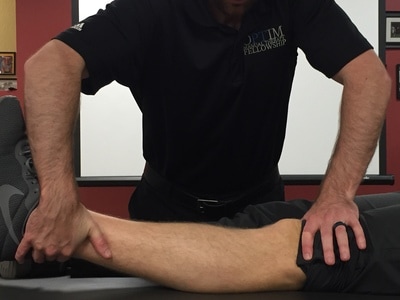- Home
- About Us
- TSPT Academy
- Online Courses
-
Resources
- Newsletter
- Business Minded Sports Physio Podcast
- Day in the Life of a Sports PT
- Residency Corner
-
Special Tests
>
-
Cervical Spine
>
- Alar Ligament Test
- Bakody's Sign
- Cervical Distraction Test
- Cervical Rotation Lateral Flexion Test
- Craniocervical Flexion Test (CCFT)
- Deep Neck Flexor Endurance Test
- Posterior-Anterior Segmental Mobility
- Segmental Mobility
- Sharp-Purser Test
- Spurling's Maneuver
- Transverse Ligament Test
- ULNT - Median
- ULNT - Radial
- ULNT - Ulnar
- Vertebral Artery Test
- Thoracic Spine >
-
Lumbar Spine/Sacroiliac Joint
>
- Active Sit-Up Test
- Alternate Gillet Test
- Crossed Straight Leg Raise Test
- Extensor Endurance Test
- FABER Test
- Fortin's Sign
- Gaenslen Test
- Gillet Test
- Gower's Sign
- Lumbar Quadrant Test
- POSH Test
- Posteroanterior Mobility
- Prone Knee Bend Test
- Prone Instability Test
- Resisted Abduction Test
- Sacral Clearing Test
- Seated Forward Flexion Test
- SIJ Compression/Distraction Test
- Slump Test
- Sphinx Test
- Spine Rotators & Multifidus Test
- Squish Test
- Standing Forward Flexion Test
- Straight Leg Raise Test
- Supine to Long Sit Test
-
Shoulder
>
- Active Compression Test
- Anterior Apprehension
- Biceps Load Test II
- Drop Arm Sign
- External Rotation Lag Sign
- Hawkins-Kennedy Impingement Sign
- Horizontal Adduction Test
- Internal Rotation Lag Sign
- Jobe Test
- Ludington's Test
- Neer Test
- Painful Arc Sign
- Pronated Load Test
- Resisted Supination External Rotation Test
- Speed's Test
- Posterior Apprehension
- Sulcus Sign
- Thoracic Outlet Tests >
- Yergason's Test
- Elbow >
- Wrist/Hand >
- Hip >
- Knee >
- Foot/Ankle >
-
Cervical Spine
>
- I want Financial Freedom
- I want Professional Growth
- I want Clinical Mastery
Posterior Drawer Test
Purpose: To assess the integrity of the PCL.
Test Position: Supine.
Performing the Test: Have the patient's affected hip and knee in a flexed position. The examiner should be seated on the patient's foot of the involved limb. The examiner should place his/her hands along the sides of the affected knee, while palpating the joint line. Apply an anterior-to-posteriorly directed force through the proximal tibia. Be sure to return to the tibia to neutral before assessing the movement. The absence of an end-feel or excessive translation compared to the non-involved side is a positive test.
Diagnostic Accuracy: Sensitivity: .90; Specificity: .99; +LR: 90; -LR: .1 ("The accuracy of the clinical examination in the setting of posterior cruciate ligament injuries").
Importance of Test: The posterior cruciate ligament is responsible for resisting against excessive posterior translation of the tibia on the femur, due to its attachments on posteriorly on the tibial plateau and anteriorly on the lateral side of the medial femoral condyle (Neumann, 2010). A posterior translation force is applied to the proximal tibia, but is blocked by an intact PCL. In the absence of a PCL, the tibia appears to is able to translate excessively. The most common mechanism for PCL injury is posterior translation at 90 degrees of knee flexion. While the PCL can be ruptured through hyperextension and hyperflexion as well, it is unlikely that it is the only ligament torn in these injuries. The ACL has been found to be stressed more than the PCL in both hyperflexion and hyperextension (Ellenbecker, 2000).
Note: these tests should only be used by properly trained health care practitioners
Test Position: Supine.
Performing the Test: Have the patient's affected hip and knee in a flexed position. The examiner should be seated on the patient's foot of the involved limb. The examiner should place his/her hands along the sides of the affected knee, while palpating the joint line. Apply an anterior-to-posteriorly directed force through the proximal tibia. Be sure to return to the tibia to neutral before assessing the movement. The absence of an end-feel or excessive translation compared to the non-involved side is a positive test.
Diagnostic Accuracy: Sensitivity: .90; Specificity: .99; +LR: 90; -LR: .1 ("The accuracy of the clinical examination in the setting of posterior cruciate ligament injuries").
Importance of Test: The posterior cruciate ligament is responsible for resisting against excessive posterior translation of the tibia on the femur, due to its attachments on posteriorly on the tibial plateau and anteriorly on the lateral side of the medial femoral condyle (Neumann, 2010). A posterior translation force is applied to the proximal tibia, but is blocked by an intact PCL. In the absence of a PCL, the tibia appears to is able to translate excessively. The most common mechanism for PCL injury is posterior translation at 90 degrees of knee flexion. While the PCL can be ruptured through hyperextension and hyperflexion as well, it is unlikely that it is the only ligament torn in these injuries. The ACL has been found to be stressed more than the PCL in both hyperflexion and hyperextension (Ellenbecker, 2000).
Note: these tests should only be used by properly trained health care practitioners
References:
Ellenbecker, Todd. Knee Ligament Rehabilitation. Philidelphia, PA: Churchill Livingstone. 20-21. Print
Neumann, Donald. Kinesiology of the Musculoskeletal System: Foundations for Rehabilitation. 2nd edition. St. Louis, MO: Mosby Elsevier, 2010. 536. Print.
Rubinstein RA, Jr., Shelbourne KD, McCarroll JR, VanMeter CD, Rettig AC. "The accuracy of the clinical examination in the setting of posterior cruciate ligament injuries." The American journal of sports medicine. Jul-Aug 1994; 22(4):550-557.
Ellenbecker, Todd. Knee Ligament Rehabilitation. Philidelphia, PA: Churchill Livingstone. 20-21. Print
Neumann, Donald. Kinesiology of the Musculoskeletal System: Foundations for Rehabilitation. 2nd edition. St. Louis, MO: Mosby Elsevier, 2010. 536. Print.
Rubinstein RA, Jr., Shelbourne KD, McCarroll JR, VanMeter CD, Rettig AC. "The accuracy of the clinical examination in the setting of posterior cruciate ligament injuries." The American journal of sports medicine. Jul-Aug 1994; 22(4):550-557.
Copyright © The Student Physical Therapist LLC 2023



